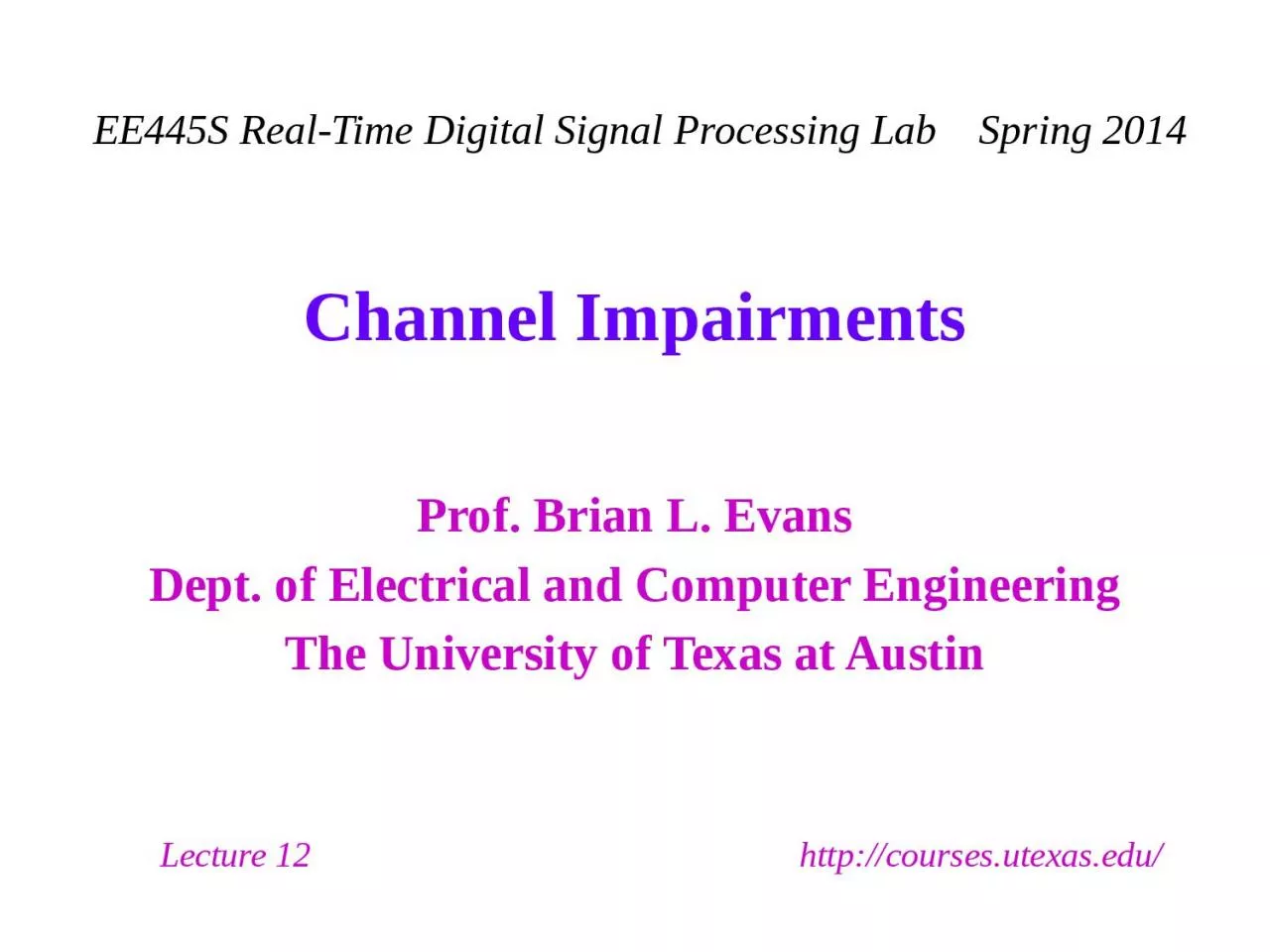

2 Outline Analog communication systems Channel impairments Hybrid communication systems Analog pulse amplitude modulation 12 3 Communication System Structure Information sources Voice music images video and data baseband signals ID: 1014843
Download Presentation The PPT/PDF document "Channel Impairments 12 -" is the property of its rightful owner. Permission is granted to download and print the materials on this web site for personal, non-commercial use only, and to display it on your personal computer provided you do not modify the materials and that you retain all copyright notices contained in the materials. By downloading content from our website, you accept the terms of this agreement.
1. Channel Impairments
2. 12 - 2OutlineAnalog communication systemsChannel impairmentsHybrid communication systemsAnalog pulse amplitude modulation
3. 12 - 3Communication System StructureInformation sourcesVoice, music, images, video, and data (baseband signals)TransmitterSignal processing block lowpass filters message signalCarrier circuits block upconverts baseband signal and bandpass filters to enforce transmission bandm(t)SignalProcessingCarrierCircuitsTransmission MediumCarrier CircuitsSignalProcessingTRANSMITTERRECEIVERs(t)r(t)CHANNELCommunication Systemsbasebandbasebandbandpassbandpassbasebandbaseband
4. 12 - 4Communication ChannelTransmission medium Wireline (twisted pair, coaxial, fiber optics) Wireless (indoor/air, outdoor/air, underwater, space) Propagating signals degrade over distanceRepeaters can strengthen signal and reduce noise m(t)SignalProcessingCarrierCircuitsTransmission MediumCarrier CircuitsSignalProcessingTRANSMITTERRECEIVERs(t)r(t)CHANNELReviewbasebandbasebandbandpassbandpassbasebandbaseband
5. 12 - 5Wireline Channel ImpairmentsLinear time-invariant effectsAttenuation: dependent on channel frequency responseSpreading: finite extent of each transmitted pulse increasesTht1TbtATb-AModel channel as LTI system with impulse response h(t)CommunicationChannelinputoutputx(t)y(t)t-A ThtTh+TbThAssume that Th < TbtTh+TbThA ThBit of ‘0’ or ‘1’
6. Wireline Channel ImpairmentsLinear time-varying effectsPhase jitter: sinusoid at same fixed frequency experiences different phase shifts when passing through channelVisualize phase jitter in periodic waveform by plotting it over one period, superimposing second period on the first, etc.Nonlinear effectsHarmonics: due to quantization, voltage rectifiers, squaring devices, power amplifiers, etc.Additive noise: arises from many sources in transmitter, channel, and receiver (e.g. thermal noise)Additive interference: arises from other systems operating in transmission band (e.g. microwave oven in 2.4 GHz band)12 - 6
7. 12 - 7Home Power Line Noise/InterferenceMeasurement taken on a wall power plug in an apartment in Austin, Texas, on March 20, 2011
8. 12 - 8Spectrally-ShapedBackground NoiseHome Power Line Noise/InterferenceMeasurement taken on a wall power plug in an apartment in Austin, Texas, on March 20, 2011
9. 12 - 9Spectrally-ShapedBackground NoiseNarrowband InterferenceHome Power Line Noise/InterferenceMeasurement taken on a wall power plug in an apartment in Austin, Texas, on March 20, 2011
10. 12 - 10Spectrally-ShapedBackground NoiseNarrowband InterferencePeriodic and AsynchronousInterferenceHome Power Line Noise/InterferenceMeasurement taken on a wall power plug in an apartment in Austin, Texas, on March 20, 2011
11. 12 - 11Wireless Channel ImpairmentsSame as wireline channel impairments plus othersFading: multiplicative noiseTalking on a mobile phone and reception fades in and outRepresented as time-varying gain that follows a particular probability distributionSimplified channel model for fading, LTI effects and additive noiseFIR+noise
12. 12 - 12Hybrid Communication SystemsMixed analog and digital signal processing in the transmitter and receiverExample: message signal is digital but broadcast over an analog channel (compressed speech in digital cell phones) Signal processing in the transmitterSignal processing in the receiverm(t)A/D ConverterError Correcting CodesDigital SignalingDecoderWaveform GeneratorEqualizerDetectiondigitalsequencedigitalsequencecodebaseband signalD/A ConverterA/DD/A
13. 12 - 13Pulse Amplitude Modulation (PAM)Amplitude of periodic pulse train is varied with a sampled message signal m(t)Digital PAM: coded pulses of the sampled and quantized message signal are transmitted (lectures 13 and 14)Analog PAM: periodic pulse train with period Ts is the carrier (below)tTsTT+Ts2Tsp(t)m(t)s(t) = p(t) m(t) Optional
14. 12 - 14Analog PAMPulse amplitude varied with amplitude of sampled messageSample message every TsHold sample for T seconds (T < Ts) Bandwidth 1/TTransmitted signalh(t) is a rectangular pulseof duration T unitstm(t)TsTT+Ts2Tss(t)m(0)m(Ts)Tth(t)1sampleholdOptional
15. 12 - 15Analog PAMTransmitted signalFourier transformEqualization of sample and hold distortion added in transmitterH(f) causes amplitude distortion and delay of T/2Equalize amplitude distortion by post-filtering with magnitude responseNegligible distortion(less than 0.5%) if msampled(t)Optional
16. 12 - 16Analog PAMRequires transmitted pulses toNot be significantly corrupted in amplitudeExperience roughly uniform delayUseful in time-division multiplexingpublic switched telephone network T1 (E1) line time-division multiplexes 24 (32) voice channelsBit rate of 1.544 (2.048) Mbps for duty cycle < 10%Other analog pulse modulation methodsPulse-duration modulation (PDM),a.k.a. pulse width modulation (PWM)Pulse-position modulation (PPM): usedin some optical pulse modulation systems. Optional